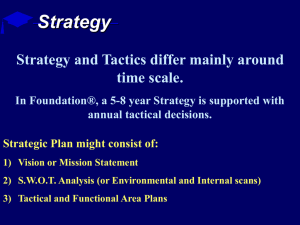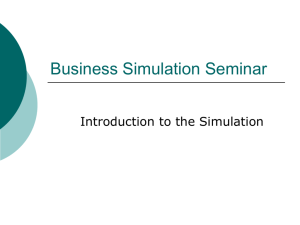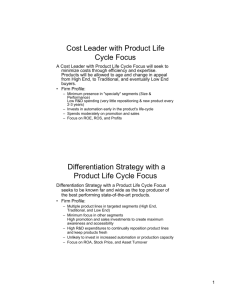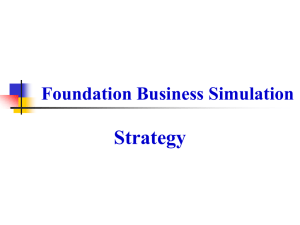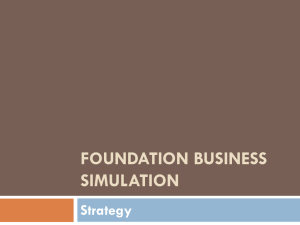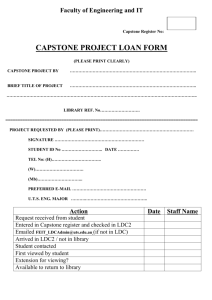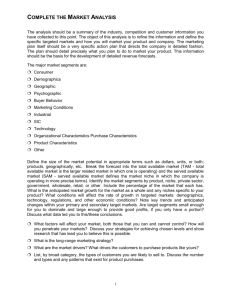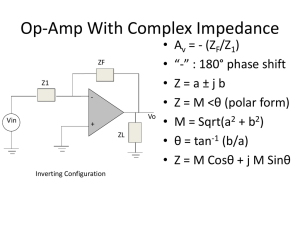Capstone_Strategies
advertisement
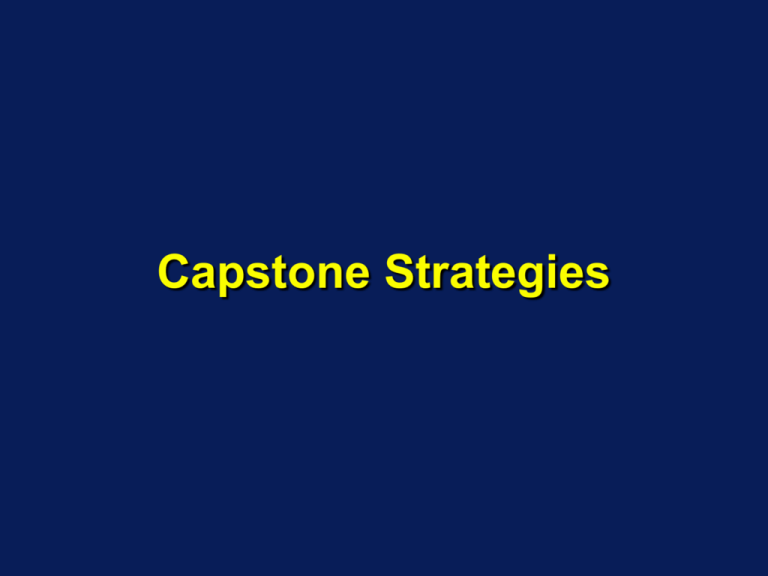
Capstone Strategies Capstone Strategies The Situation Analysis provided an overview of the forces at work within the Capstone market place. Now you must decide how to use that information to gain a competitive advantage. There are many different approaches - all of which can be successful depending on how well they are implemented tactically. OBJECTIVES Learn how organizational strategy relates to the simulation Gain an understanding of the issues surrounding business planning Make business planning functional decisions for current year PROCESS Develop a corporate strategy and mission statement for your team (review your Situation Analysis) Outline your company’s Marketing, Production, R&D, and Financial intents CAPSTONE STRATEGIES STRATEGY Mission Statement INDUSTRY AND MARKET ANALYSIS S.W.O.T Analysis Competitor Analysis Competitive Analysis PERFORMANCE ASSESSMENT Success Measurements Ratios Statistics FUNCTIONAL PLANNING Marketing Production Finance R&D HR Strategies are declared in corporate mission statements Capstone firms may develop and execute any strategy (or none at all - though that isn’t advisable). Basic strategies include: Overall Cost Leader Cost Leader with Focus (Low Tech or Product Life-Cycle) Differentiator Differentiator with Focus (High-Tech or Product Life-Cycle) OVERALL COST LEADER An overall cost leader will attempt to be the low-cost producer in every segment of the market. They will have good profit margins on all sales while keeping prices low for price-sensitive customers. Firm Profile: More likely to re-position products than introduce new ones to the market Capacity improvements are unlikely to be undertaken (may run overtime instead) Automation may be pursued to increase margins Investments will be financed with debt and/or stock issues Tend to spend less on promotion and sales Focus on Market Share, Profits, and Stock Price COST LEADER WITH LOWTECH FOCUS A low-tech focused cost leader seeks to dominate the price sensitive market segments. Their aim is to set prices below all competitors and still be profitable. Firm Profile: Multiple product lines in the low-tech segments (Low & Traditional) Invest heavily in automation Spend heavily on advertising to cost sensitive customers (sales people have more than one product to pitch to prospects) Investments financed with debt and/or stock issues Focus on ROS, ROE, and Profits COST LEADER WITH PRODUCT LIFE-CYCLE FOCUS A product life-cycle focused cost leader will seek to minimize costs through efficiency and expertise. Products will be allowed to age and change in appeal from high-tech, to traditional, and eventually low end buyers. Firm Profile: Minimum presence in “specialty” segments (Size & Performance) Low R&D spending (very little re-positioning & new product every 2-3 years) Invest in automation early in the product’s life-cycle High spending on promotion and sales Focus on ROE, ROS, and Profits OVERALL DIFFERENTIATOR A Differentiator will seek to create maximum awareness and brand equity. They want to be well known as makers of high quality/highly desirable products. Firm Profile: High R&D spending to keep products fresh Maintain a presence in all market segments Spend heavily on advertising and sales to create maximum awareness and accessibility Prices tend to be higher Focus on Market Share, Profits, and Stock Price DIFFERENTIATOR WITH HIGH-TECH FOCUS A high-tech differentiator seeks to be known far and wide as the top producer of the best performing state-of-the-art products. Firm Profile: Multiple product lines in high-tech segments (High, Performance, and Size) Minimum focus in other segments High promotion and sales investments to create maximum awareness and accessibility High R&D expenditures to continually introduce new product lines and keep existing products fresh Unlikely to invest in increased automation or production capacity Focus on ROA, Asset Turnover, and ROE DIFFERENTIATOR WITH PRODUCT LIFE-CYCLE FOCUS A product life-cycle differentiator seeks to be well-known as a top producer of good performing products in each of the targeted segments. Firm Profile: Multiple product lines in targeted segments (High, Traditional, and Low) Minimum focus in other segments High promotion and sales investments to create maximum awareness and accessibility High R&D expenditures to continually re-position product lines and keep products fresh Unlikely to invest in increased automation or production capacity Focus on ROA, Stock Price, and Asset Turnover SUMMARY There is no “magic bullet” strategy in Capstone. Successful teams will develop a cogent longrange plan, align their internal functions in support of the plan, and adjust as dictated by the opportunities and realities of the market place. Lessons of Importance Prepare the Situation Analysis master schedule with Sweet Spot locations, max price ceilings, basic demand analysis, and investment points for each segment. Use this master schedule to develop a comprehensive strategic plan for the 8 years of the simulation. Align your strategy with the vision and mission statement for the company, and the performance goals with your strategy. Remember strategy balances planning formulation and implementation with industry opportunity and threat recognition (don’t lock in on one while ignoring the other). Recognize and account for the Rough & Fine Cut characteristics for segment; Performance, Size, Reliability, Age & Price. Keep track of major decisions and outcomes; you will be preparing a stockholders’ report based on these decisions.
